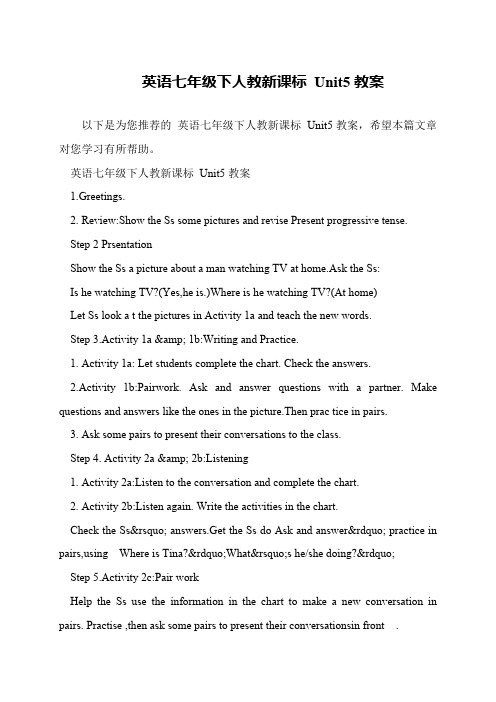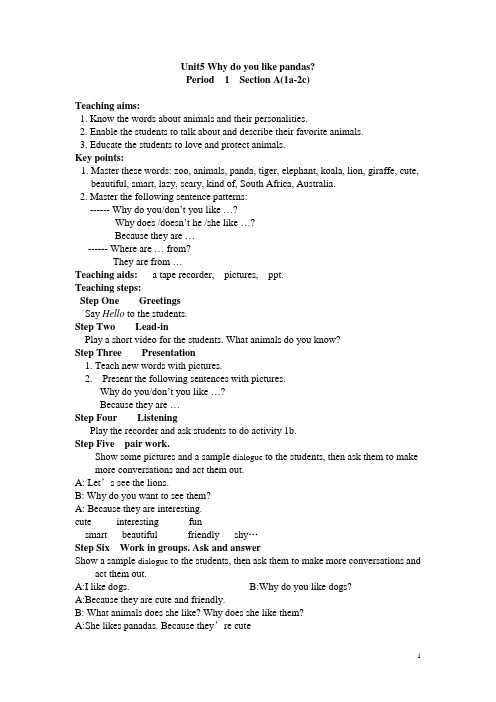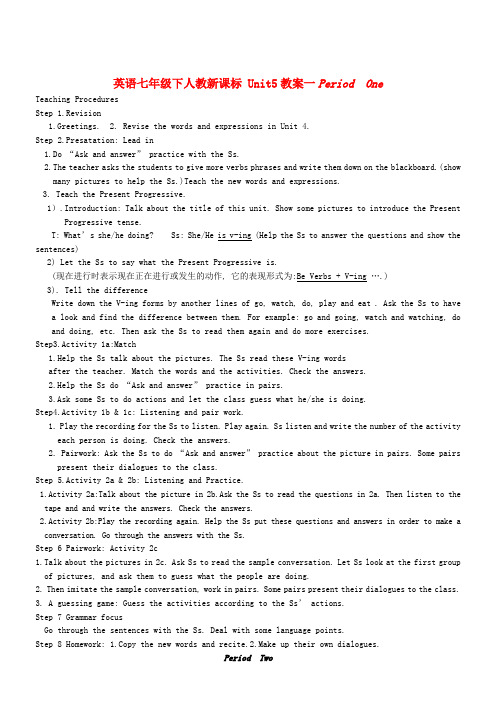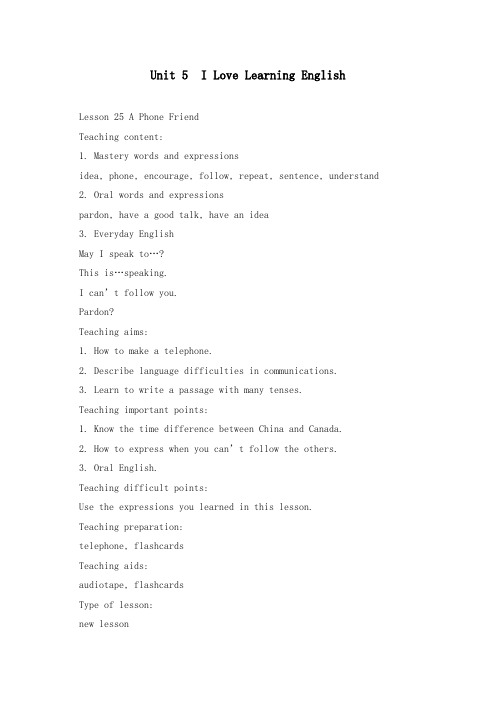英语七年级下人教新课标 Unit5教案
人教版七年级下英语Unit5教案、导学案

Unit 5 Why do you like pandas?话题Topic 动物园的动物(Animals in a zoo)功能Functions 1.能够描述各种常见动物(Describe animals)Pandas are kind of interesting.Lions are scary.The dog is really cute.The cat is kind of boring.2.能表达自己对动物的喜好(Express preferences)A:Why don’t you like tigers?B:Because they’re scary.语法Grammar 1.能够正确使用why,what和where引导的疑问句进行问答(Wh-questions and answers)A:Why do you like pandas?B:Because they’re kind of interesting.A:Where are lions from?B:They’re from South Africa.A:Why don’t you like tigers?B:Because they’re scary.2.能正确使用表示性质和品质的形容词(Adjectives of quality)Your dog is really cute.He is very smart.She’s kind of boring.词汇和常用表达Words & expressions 1.能正确使用下列词汇 (Curriculum words)(按词性排列)名词:panda,zoo,tiger,elephant,lion,giraffe,animal,kind,Australia,south, Africa,pet,leg,cat,flag,place,water,danger,tree动词:sleep,save,forget,cut,kill形容词:cute,lazy,smart,beautiful,friendly,shy其他:down,over2.能正确使用下列常用表达(Useful expressions)kind of,South Africa,a lot,one of,be in great danger,cut down,getlost,madeof3.能认读下列词汇(Non-curriculum words) koala,scary,Thailand,symbol,ivory,Thai学习策略Strategies 1.能借助上下文语境猜出部分词汇的含义2.能够根据词汇的含义、性质、特点等分类记忆单元词汇3.能根据阅读语篇内容构建思维导图4.能通过各种方式搜集有关动物的信息和资料文化知识Culture 了解世界各地的典型动物三维目标Three-dimensionaltarget 知识与技能1.能掌握以下单词:panda,zoo,tiger,elephant,koala,lion,giraffe,animal,cute,lazy,smart,beautiful,scary,kind,Australia,south,Africa,pet,leg,cat,sleep,friendly,shy,save,symbol,flag,forget,place,water,danger,cut,down,tree,kill,ivory,over,Thailand,Thai2.能熟练掌握单元短语:kind of,walk on two legs,South Africa,alot,one of,be in great danger,cut down,for a long time,getlost,made of3.能掌握以下句型:A:What animals do you like?B:I like koalas.三维目标Three-dimensionaltarget 知识与技能A:Why do you like koalas?B:Because they’re very cute.A:Where are koalas from?B:They’re from Australia.4.了解以下语法:(1)Wh-questions的意思、构成和回答:Why do you like pandas?Becausethey’re cute.Where are they from?They’re from China.(2)形容词表示性质、特点和品质:cute,beautiful,smart,lazy等。
七年级英语下册《Unit5Whydoyoulikepandas》教案1(新版)人教新目标版

七年级英语下册《Unit5Whydoyoulikepandas》教案1(新版)⼈教新⽬标版Why do you like pandas单元教材分析课标要求:基础教育阶段英语课程的总体⽬标是培养学⽣的综合语⾔运⽤能⼒。
综合语⾔运⽤能⼒的形成建⽴在学⽣语⾔技能、语⾔知识、情感态度、学习策略和⽂化意识等素养整体发展的基础上。
七年级学⽣达到的⽬标应该是:对英语学习表现出积极性和初步的⾃信⼼。
能听懂有关熟悉话题的语段和简短的故事。
能与教师或同学就熟悉的话题(如学校、家庭⽣活)交换信息。
能读懂⼩故事及其他⽂体的简单书⾯材料。
能参照范例或借助图⽚写出简单的句⼦。
能参与简单的⾓⾊扮演等活动。
能尝试使⽤适当的学习⽅法,克服学习中的困难。
能意识到语⾔交际中存在的⽂化差异。
单元内容分析:本单元的中⼼话题是运⽤⼀些描述性的词语来描述⼀些动物,并说明⾃⼰对这些动物喜好的原因以及简要的介绍动物的源地。
第⼀部分通过动物与图⽚的配对,引导出本部分中关于各种动物的名称的重点词汇和句型,利⽤问句Why do you like …?及回答Because they are…来练习巩固⽬标语⾔。
在第⼆部分主要训练学⽣的听说演及归纳总结的能⼒,并且通过调查和谈论⾃⼰或他⼈喜爱的动物来巩固⽬标语⾔。
第三部分在训练听⼒的同时,⼜增加了⾃⼰喜爱动物的原因,并对学⽣进⾏热爱动物的情感教育。
第四部分主要是让学⽣⾃⼰运⽤描述性词语来综合介绍⾃⼰所喜爱的动物,巩固整单元⽬标语⾔。
教学⽬标:1.知识⽬标:单词及短语:panda, zoo, tiger, elephant, koala, lion, giraffe, animal, cute, lazy, smart, beautiful, scary, kind, Australia, south, Africa, pet, leg, cat, sleep, friendly, shy, save, symbol, flag, forget, place, water, danger, cut, down, tree, kill, ivory, over, kind of, south Africa, be friendly to, get lost/be lost, be in danger, cut down, be made of , let’s, kind of interesting, be from/come from, walk on two legs, have a pet, sleep all day, a good name for her, black and white, save the elephants, one of the Thailand’s symbols, a symbol of good luck, for a long time, lose their homes, save the trees句型:Why do you like pandas? —Because they’re kind of cute.What animals do you like? I like lions.Where are the lions from? They’re from South Africa.She is beautiful but she is very shy.They can also remember places with food and water.语法:⑴特殊疑问句( 特殊疑问词+ ⼀般疑问句) 与特殊疑问词 What,Who,Where,Why,Whose,When,How,Where are you from? Who is he? How is your mother?Why do you want to go to Beijing?⑵ Why 引导的特殊疑问句Why do you like pandas?—Because they are kind of cute.2.能⼒⽬标:能够谈论⾃⼰喜欢的动物并陈述原因。
人教版新目标七年级英语下册 Unit 5 教案

人教版新目标七年级英语下册 Unit 5 教案一. 教材分析人教版新目标七年级英语下册Unit 5主要讲述了日常生活中的一些活动,如游泳、打篮球、跳舞等。
本单元的话题贴近学生的生活,有利于激发学生的学习兴趣。
教材通过听说读写等多种活动,帮助学生掌握日常生活中的交际用语,提高学生的语言运用能力。
二. 学情分析七年级的学生已经掌握了基本的英语语法和单词,对于日常生活中的交际用语也有了一定的了解。
但部分学生可能在发音和口语表达上还存在困难,需要教师在教学中加以引导和纠正。
此外,学生可能对一些体育活动相关的词汇和表达不够熟悉,需要在课堂上进行拓展和练习。
三. 教学目标1.知识目标:学生能够掌握本单元的生词和短语,了解日常生活中的交际用语。
2.能力目标:学生能够听懂、会说、会读、会写与日常生活相关的英语句子。
3.情感目标:学生能够积极参与课堂活动,提高学习英语的兴趣。
四. 教学重难点1.重点:本单元的生词和短语,日常生活中的交际用语。
2.难点:情态动词can的用法,以及与日常生活相关的句型结构。
五. 教学方法1.任务型教学法:通过设置各种任务,让学生在完成任务的过程中学习英语。
2.情景教学法:创设各种生活情境,让学生在真实的环境中学习英语。
3.交际法:鼓励学生积极参与课堂交际,提高口语表达能力。
六. 教学准备1.准备单词卡片、短语卡片、图片等教学辅助材料。
2.准备与本单元话题相关的视频或音频材料。
3.准备课堂练习题和测试题。
七. 教学过程1.导入(5分钟)利用图片或视频引导学生谈论日常生活中喜欢的活动,引出本课话题。
2.呈现(10分钟)老师展示本课的生词和短语,让学生朗读并解释其意思。
同时,老师用情态动词can提问,引导学生回答。
3.操练(15分钟)学生分角色扮演,用情态动词can进行问答。
老师巡回指导,纠正发音和表达错误。
4.巩固(10分钟)学生完成课堂练习题,老师及时批改和讲解。
5.拓展(5分钟)老师引导学生谈论更多关于日常活动的表达,如游泳、打篮球、跳舞等。
【人教版】新目标七年级下册英语:Unit 5教案

Unit 5 Why do you like pandas?Section A (1a-2d)一、教学目标:1. 语言知识目标:1) 能掌握以下单词:tiger, elephant, panda, lion, koala, giraffe, cute, lazy, smart, beautiful, scary, kind, kind of, Australia, south, Africa, South Africa, pet, leg, cat, sleep2) 能掌握以下句型:① What animals do you/does she/ does he like?②Let’s see the …?③Why do you/does she/ does he want to see …?④Because they are ….2. 能力目标:① To observe and describe animals.② To talk about their preferences③ To know the implied meaning of some animals2. 情感态度价值观目标:动物和人类都生活在同一地球上,动物是我们的朋友。
我们人类应该与动物和谐相处,共同生存。
我们应当学会关爱动物,保护动物。
二、教学重难点1. 教学重点:1) 学会描述动物的性格及特点。
2) 学会表达喜欢某类动物及说明喜欢的原因。
2. 教学难点:名词的复数形式表示一类事物;第三人称单数形式三、教学过程Ⅰ. Warming-up and lead inTo create an English environment, the teacher shows the class some pictures of a zoo. And ask some questions about animals:Do you like to go to the zoo?Do you like animals?Then have them to recall the animals they had learned and write them on the blackboard as he/she can.( e.g. animals,sheep, monkey, cat, dog, mouse, cow, duck… )Ⅱ. Presentation1. Ask them to talk with their partners about the animals they like using the words they know (Four students a group).—What animals do you like?—Why do you like…—Because they’re…2. Then show the class some pictures of animals and present other animals. And ask them:What’s this in English?It's a tiger. (Then lion, panda, elephant, koala, giraffe)Ss look at the picture and try to remember the new words of the animals.3. Next, glue the pictures on the blackboard and ask one student to match the pictures with the words on the cards. Other students turn to page 25 and finish 1a.4. Check the answers with the class.Ⅲ. Game (Guessing game.)T: Show some pictures on the big screen. Let Ss guess what animal it is.Ss try to guess and remember the names of the animals.Ⅳ. ListeningWork on 1b.Tell Ss to listen to the tape and check the animals they hear in 1a.Play the recording again and check the answers with the class.Ⅴ. Pair work1. Ask the students to imagine “ We are in the zoo, there are many kinds of animals here.”Then ask a student to do the model with you:—Let’s see the lions first.—Why? (why do you /does she /does he like lions?)—Because they are interesting.2. Ss work with their partners practice the conversation using the animal in 1a.Ⅵ. Listening1. Work on 2a;T: Listen to the conversation carefully. Then write the names of the animals you hear on these lines.Play the recording the first time. Students only listen.Play the recording a second time. This time students write in the names of the animals. Check the answers.Point out the adjectives and countries listed on the right. Ask a student to say the words. Say, Now I will play the recording again. This time draw a line between each animal and the adjective and countries you hear.Play the recording and have students match each animal with an adjective and a country. Correct the answers.2. Work on 2bT: Listen again and complete the conversation with the words in 2a.Play the recording for the Ss to listen and write the answers.Check the answers with the class.Ⅶ. Pair work1. Ask two students to read the conversation in 2b to the class.2. Ss practice the conversation in pairs.3. Then show the transcription on the big screen and practice the other two conversations in 2a.4. Ss practice the conversations in pairs.Ⅷ. Role-play1. Ask Ss to look at the picture in 2d. Then Ss read the conversation in 2d and find the answers to the questions:① Does Peter have a pet?② What can Dingding do?③What pet does Jenny’s mom have?④ Does Jenny like the cat? Why?2. Ss read the conversations and try to find the answers to the questions.Check the answers:Yes, he does.He can walk on two legs. He can dance, too.She has a cat.No, she doesn’t. Because it’s very lazy.3. Ss work in pairs and practice the conversation.4. Let some pairs role-play the conversation.Homework:1. Remember the new words and expressions in this period.2. Role-play the conversation after class.3. Write the animal's names as many as possible in the exercises book.板书设计:Section A (Grammar Focus-3c)一、教学目标:1. 语言知识目标:1) 继续练习运用如何做描述动物及表述自己对动物的喜好。
人教版英语七年级下册Unit5单元整体课教学设计

4.多元化评价,关注学生全面发展:采用形成性评价与终结性评价相结合的方式,全面评估学生的英语水平。注重学生的个体差异,鼓励学生自我评价、相互评价,使评价成为促进学生发展的手段。
3.教师以提问的方式引导学生回顾之前学过的一般现在时,为新课中的语法点做好铺垫。
(二)讲授新知,500字
在讲授新知环节,教师按照以下步骤进行:
1.引导学生跟读并学习本单元的核心词汇,如clean, sweep, mop等,让学生在语境中理解和记忆单词。
2.通过示例和练习,教授一般现在时的用法,强调主语为第三人称单数时,动词要加-s或-es的规则。
2.口语作业:分组进行角色扮演,每组选择一个日常活动主题,如“school day”, “weekend activities”等,用英语进行对话。要求每个成员都参与其中,尽可能多地运用本单元所学的词汇和句型。
3.听力作业:学生在家观看与本单元主题相关的英语视频,如日常生活、兴趣爱好等,然后回答相关问题。此作业旨在提高学生的听力理解能力和信息获取能力。
2.过程与方法方面:引导学生运用自主学习与合作学习的方式,提高英语听说读写能力。难点在于如何激发学生的学习兴趣,使其主动参与课堂活动,提高课堂互动效果。
3.情感态度与价值观方面:培养学生积极向上的生活态度和良好的学习习惯。难点在于如何引导学生树立正确的价值观,将所学知识运用到实际生活中。
(二)教学设想
5.情感教育,培养良好价值观:在教学过程中,关注学生的情感需求,引导他们树立正确的价值观。通过课堂讨论、课后作业等方式,让学生认识到合理安排日常活动的重要性,培养其热爱生活、珍惜时间的观念。
新目标英语人教版七年级下册Unit5_Section_A_教学设计

《I’m watching TV.》教学设计乾安县大布苏镇兰字中学张连甲教材依据:人教版七年级下册第五单元《I’m watching TV.》Section A Period1设计思想本单元的话题是谈论某人正在干什么。
要求通过学习有关的短语及句型掌握现在进行时的定义及用法,因此,我设计了通过师生做某些动作进而导入新的时态的方式。
学生很自然就会明白了这个单元将要讨论的话题。
对于教材的使用我设计将活动通过小组合作及表演练习的方式对所学的新句型进行理解应用。
一方面让所有学生都有机会进行说的练习,另一方面也让学生在问答的过程中能及时纠正错误,莫忘be后加ing . 在教学过程中,关注学生的生活实际,以学生为本,提倡学生参与、体验、亲身实践、独立思考、合作探究,从而实现教学方式和学习方式的转变。
教学分析本节课围绕着一个话题“谈论现在正在进行或发生的动作”来展开教学活动,主要的教学内容是现在进行时。
本节课紧扣教材,重新对教材进行编排。
先通过描绘图片中人们的活动来学习词汇: doing homework, watching TV, cleaning, reading, eating dinner, ……并通过问答“人们正在做什么”来学习句型:What are you doing?I’m watching TV .并用前后桌或同桌合作的方式进一步加强句型的操练。
然后通过听力训练和写作训练来加强练习和巩固。
教学目标1.Knowledge Objects:(1) New words and phrases(2) Present progressive tense2.Ability Objects:To talk about or learn about what they are doing3.Moral ObjectsTo be friendly to somebody教学重点1.Key V ocabulary2.Present progressive tense:A +be+doing +其它教学难点To master the usage of Present progressive tense:A +be+doing +…其它教学方法Listening writing reading practicing playing games教学课时安排一课时教学过程Step1: Warming up and lead-in(1). I show a basketball and say: look, I like playing basketball. I’m playing basketball now. I’m talking now.I’m running.When I make the actions,I ask some students to guess the meaning of the sentences.(老师边做动作边说句子,引出本课的内容,让学生明了现在进行时的句子构成及表达的意思,进而引起学生对本课的兴趣。
英语七年级下人教新课标 Unit5教案

英语七年级下人教新课标Unit5教案以下是为您推荐的英语七年级下人教新课标Unit5教案,希望本篇文章对您学习有所帮助。
英语七年级下人教新课标Unit5教案 1.Greetings. 2. Review:Show the Ss some pictures and revise Present progressive tense. Step 2 Prsentation Show the Ss a picture about a man watching TV at home.Ask the Ss: Is he watching TV?(Yes,he is.)Where is he watching TV?(At home) Let Ss look a t the pictures in Activity 1a and teach the new words. Step 3.Activity 1a & 1b:Writing and Practice. 1. Activity 1a: Let students complete the chart. Check the answers. 2.Activity 1b:Pairwork. Ask and answer questions with a partner. Make questions and answers like the ones in the picture.Then prac tice in pairs. 3. Ask some pairs to present their conversations to the class. Step 4. Activity 2a & 2b:Listening 1. Activity 2a:Listen to the conversation and complete the chart. 2. Activity 2b:Listen again. Write the activities in the chart. Check the Ss’ answers.Get the Ss do Ask and answer” practice in pairs,using Where is Tina?”What’s he/she doing?” Step 5.Activity 2c:Pair work Help the Ss use the information in the chart to make a new conversation in pairs. Practise ,then ask some pairs to present their conversationsin front .。
新版人教版七年级英语下册第五单元教案

Unit 5 Why do you like koalas?一、考点、热点回顾【重点单词】__________ adj、可爱得,机灵得__________ adj、懒惰得__________ adj、聪明得__________adj、美丽得,美好得__________ n、种类__________v & n、睡觉__________adj、友好得__________ adj、害羞得___________ v、拯救__________ v、忘记,遗忘__________ n、危险___________ prep、超过,多于【重点短语】________ 有点,稍微____________ 整天_________ 很,非常_________ 对…友好________ …中之一_____________ 处于危险之中____________ 砍到【重点句型】1.让我们去瞧熊猫吧。
____________ __________ the pandas___________、2.您为什么想瞧它们?_________ do you _________ _________ see them ?3.我非常喜欢老虎。
I _________ tigers __________ __________、4、难道她不美丽吗?__________ she ___________ ?【重点语法】:形容词与疑问副词why得用法(1)、形容词得概念形容词表示人或事物得性质,特征,特点等(2)、形容词得位置形容词作定语修饰名词时,要放在名词得前面eg:I have a lovely dog、但就是如果形容词修饰something, anything, nothing等不定代词时,要放在这些不定代词得后面。
如: There is something wrong with the bike、这辆自行车出毛病了。
(3)、形容词得用法除了可以作定语、表语、宾语补足语以外,有些形容词还可以与定冠词连用,表示一类人或事物,这时,它相当于一个名词,可以作主语或宾语。
人教七年级下册Unit5全单元教学设计

1.教学内容:设计听力、口语、阅读和写作练习,巩固现在进行时的用法。
2.练习形式:听力练习(听描述,判断动作)、口语练习(角色扮演)、阅读练习(理解短文,回答问题)、写作练习(编写对话)。
3.教师指导:针对练习中的难点,给予提示和讲解。
4.学生练习:认真完成练习,巩固所学知识。
(五)总结归纳
3.重点:通过小组合作、讨论等形式,培养学生的团队协作能力和跨文化交际意识。
难点:引导学生主动参与,提高其在合作学习中的积极性和责任感。
(二)教学设想
1.针对重难点,采用以下教学策略:
a.利用多媒体资源、图片等辅助教学手段,创设生动、具体的情境,帮助学生理解和掌握现在进行时。
b.设计丰富的听说练习,如角色扮演、小组讨论等,让学生在实际语境中运用所学知识,提高口语表达能力。
本教学设计旨在帮助学生全面掌握本单元的知识与技能,培养其语言运用能力,同时注重培养学生的情感态度与价值观,使其成为具有国际视野和跨文化交际能力的优秀人才。
二、学情分析
针对人教版七年级下册Unit 5 I'm watching TV,学生已具备以下基础:
1.掌握了一些日常活动词汇,如:play, read, write等,为学习本单元动词短语打下基础。
2.教师提问:What are they doing?学生回答后,教师板书:“I'm reading a newspaper./She's watching TV./He's playing the guitar./She's talking on the phone.”,引出本单元的主题——现在进行时。
d.互动:组织学生进行小组合作、角色扮演等活动,促进师生、生生之间的互动交流。
人教新目标七年级英语下册教案:Unit 5 Why do you like pandas Section A Grammar Focus-3c (语法课型)

Unit 5 Why do you like pandas? Section A Grammar Focus-3c (语法课型)Teaching aims (教学目标)1. 熟悉动物的名称(单复数形式和读音);熟悉动物的特性(cute, smart, etc.)以及代表的国家2. 谈论自己喜欢的动物并陈述理由;学问他人对动物的喜好以及理由;3. 热爱动物,培养人和动物之间的和谐关系Language points (语言点)1. 词汇:box, very, kind of2. 句型:Why questions:Why do you like …?does he/she like …?Because they’re …Difficulties (教学难点)Writing sentencesTeaching steps (教学步骤)1.Warm-up and revision (课堂热身和复习)Greet Ss.Talk about the animals =Ss learned about in the first period.【教学设计说明】通过描述动物,达到复习与巩固的作用。
同时增进同学之间的相互了解。
2. Work on 2d(完成2d)(1)Read the conversation and answer the following questions.Q1. Why does Peter like his dog?Q2. What can Dingding do?Q3. Why doesn’t Jenny like the cat?(2) Role-play the conversation in 2d.(3) Have Ss make conversations using 2d as an example.【教学设计说明】学生通过回答问题能理解对话的内容,通过角色扮演能在情境中学会运用,通过自编对话能更好的让学生学以致用。
英语七年级下人教新课标 Unit5教案

英语七年级下人教新课标 Unit5教案知识目标1.学生能够掌握以下单词:take, subway, by, bus, ride, bike, walk, go, school, home, to, house, get, off, then, turn, right, left, street。
2.学生能够掌握以下句型:I take the subway to school; He goes to school by bus; She rides her bike to work; They walk to the park; We take the bus home; You get off at the next stop。
3.学生能够通过练习运用所学知识进行口语表达。
课程重点1.掌握本单元中所学的单词和句型。
2.通过对话等实践练习,提高学生的口语表达和听力能力。
课程难点1.学生需要理解不同交通工具以及如何表达所需去的地点。
2.学生需要掌握如何运用所学内容进行实践练习。
教学方法1.采用听力练习、口语对话等多种教学方法,提高学生的听说能力。
2.通过对话练习、角色扮演等形式,让学生更好地理解和掌握所学内容。
教学程序Step 1 导入新课1.老师向学生出示本单元与交通出行相关的图片,并让学生根据图片描述交通工具及其所在位置。
2.引出新单词和句型。
Step 2 学习新知1.利用多媒体课件,带领学生进一步学习相关单词和句型。
2.通过示范一些典型的句型,让学生掌握如何运用所学内容进行表达。
Step 3 练习实践1.老师组织学生进行对话,模拟不同交通情境。
2.让学生进行口语练习、课堂展示和互动交流。
Step 4 拓展延伸1.组织学生进行小组活动,增强学生合作意识。
2.让学生自主进行拓展练习,拓展句型和词汇知识。
Step 5 课堂总结1.老师总结本节课的学习重点和难点。
2.让学生进行反复练习和巩固。
师生互动1.教师维持课堂氛围,引导学生激发学习兴趣。
人教版英语七年级下册Unit5优秀教学案例

三、教学策略
(一)情景创设
1.利用多媒体课件展示不同国家的生日庆祝方式,引导学生谈论他们自己的生日经历,激发学生的学习兴趣和参与度。
2.通过展示生日派对的场景,让学生在真实语境中感知和理解一般现在时态的用法,提高他们的语言运用能力。
3.设计生日主题活动,如角色扮演、小组讨论等,让学生在实际情境中运用所学知识,增强他们的实践能力。
(二)问题导向
1.设计有针对性的问题,引导学生思考和探索生日相关的主题,如“你最喜欢的生日礼物是什么?”“你通常如何庆祝生日?”等,激发学生的思维能力和问题解决能力。
2.通过提问和回答的方式,引导学生运用一般现在时态描述自己的生日活动,提高他们的语言表达能力和交际能力。
3.鼓励学生提出问题,培养他们的提问意识和主动学习的习惯,帮助他们更好地理解和掌握知识。
4.引导学生思考和探索生日相关的主题,如“你最喜欢的生日礼物是什么?”“你通常如何庆祝生日?”等,激发学生的思维能力和问题解决能力。
(二)讲授新知
1.讲解一般现在时态的构成和用法,让学生掌握一般现在时态的句子结构,如主语+动词原形。
2.通过示例和练习,让学生熟悉和掌握一般现在时态下描述日常活动的交际用语,如“I like playing soccer.”、“She celebrat等。
(三)小组合作
1.组织学生进行小组合作,让他们共同完成生日主题的任务,如讨论生日庆祝方式、设计生日派对等,培养他们的团队合作能力和沟通能力。
人教版新目标七年级英语下unit5教案

让学生学会运用描述性形容词并结合程度副词对事物进行描述。
教学方法
交际功能法、任务型教学法和分层教学法
二、【教学流程】
环节
师生活动
二次备课
I.复习
热身
1. The teacher asks some questions, and Ss answer them.
T: Where are you from?
—Where are they from? They’re fromChina.
能力
目标
通过听说读写训练,学会初步运用新单词和句型来谈论对动物的喜好以及动物的产地。
情感
目标
培养学生热爱动物,保护动物的良好品质;相信:动物是人类的好朋友。
教学重点
动物名称,描述动物特点的形容词,why引导的特殊疑问句及简答。
2. Activity 2a2b
(1) Listen and write the animals you hear.
Draw a line from the animals to the description words and the countries they are from. (2a)
Answers: pandas kind of interestingChina
Where do lions come from? They come fromSouth Africa.
2. Read and translate.
G
III.强化
巩固
1. Activity 3a
Fill in the blanks with the words from the box.
Answers: Where, They’re, like, don’t, Why, because, do, cool
人教版英语七年级下册Unit5sectionB1a1d教学设计

3.阅读理解:教师提供一篇关于某个节日的历史背景和庆祝方式的英文短文,学生阅读后,完成相关的阅读理解题目,以加深对节日文化的理解。
4.创意任务:鼓励学生设计一个自己的节日,包括节日名称、庆祝时间、活动内容等,并用英语制作一份节日宣传海报,展示他们的创意。
3.学生在词汇方面,对于本节课的核心词汇和短语掌握程度不一。教师需要针对学生的个体差异,采用分层教学策略,帮助学生在原有的词汇基础上逐步提高。
4.学生在听说读写方面的能力发展不平衡,部分学生口语表达能力较弱。因此,在教学过程中,教师应注重培养学生的口语表达能力,鼓励他们大胆开口说英语,增强自信心。
5.学生在小组合作学习中,团队协作意识和沟通能力有待提高。教师应关注学生在小组活动中的表现,引导他们学会倾听、尊重他人意见,提高团队协作能力。
5.词汇复习:要求学生利用课后时间复习本节课所学的词汇和短语,通过制作单词卡片、词汇墙等方式进行记忆巩固。
6.家庭作业:家长协助学生一起完成一个节日主题的调查研究,选择一个节日,了解其起源、在全球的庆祝方式以及人们对这个节日的看法,并以书面报告的形式提交。
教师在布置作业时,应强调作业的目的是为了帮助学生巩固知识,提高语言运用能力,并鼓励学生在完成作业的过程中,积极探索和发现语言学习的乐趣。同时,教师应告知学生,作业完成后将进行反馈和评价,以激发学生的积极性。通过这些多样化的作业形式,学生不仅能够巩固所学,还能提高综合语言运用能力,培养跨文化交际意识。
2.每个小组选一名代表汇报讨论成果,其他小组成员补充。在此过程中,教师巡回指导,关注学生的语言表达和词汇运用,及时纠正错误。
人教新版英语七年级下册Unit5全单元教案

Unit5 Why do you like pandas?Period 1 Section A(1a-2c)Teaching aims:1. Know the words about animals and their personalities.2. Enable the students to talk about and describe their favorite animals.3. Educate the students to love and protect animals.Key points:1. Master these words: zoo, animals, panda, tiger, elephant, koala, lion, giraffe, cute,beautiful, smart, lazy, scary, kind of, South Africa, Australia.2. Master the following sentence patterns:------ Why do you/don’t you like …?Why does /doesn’t he /she like …?Because they are …------ Where are … from?They are from …Teaching aids: a tape recorder, pictures, ppt.Teaching steps:Step One GreetingsSay Hello to the students.Step Two Lead-inPlay a short video for the students. What animals do you know?Step Three Presentation1. Teach new words with pictures.2. Present the following sentences with pictures.Why do you/don’t you like …?Because they are …Step Four ListeningPlay the recorder and ask students to do activity 1b.Step Five pair work.Show some pictures and a sample dialogue to the students, then ask them to make more conversations and act them out.A: Let’s see the lions.B: Why do you want to see them?A: Because they are interesting.cute interesting funsmart beautiful friendly shy…Step Six Work in groups. Ask and answerShow a sample dialogue to the students, then ask them to make more conversations and act them out.A:I like dogs. B:Why do you like dogs?A:Because they are cute and friendly.B: What animals does she like? Why does she like them?A:She likes panadas. Because they’re cuteStep 7 Listening1. Listen and complete 2a. Play the recorder twice, for the first time , students findout the animals they hear. Then they guess the description words and countries.Next, play the recorder for the second time and students to make sure theanswers.2. Listen and complete 2b.Step Seven Pair work1.Present a map of the world to teach new words and the new sentence pattern“Where are they from?”“They are from…”2. Show some pictures of animals and have students make conversations with thefollowing sentences:A: Let’s see…Do you like …? B:Yes, I do./ No, I don’t.A: Why do you/ don’t you like them? B: Because they are… .A: Where are they from? B: They are from… .3. Ask several pairs to show their conversations.Step Eight Survey1. Ask students to work in groups and do a survey.2. Fill in the chart about the survey .3. Ask students to do a report about their survey results.Step Nine Homework1. Make a list of the animals you know and try to describe each animal with a wordwe learnt in this class.2. Write an article about your favorite animals and describe their appearances, personalities, food, hobbies and where they are from.Period 2 Section A (1a-2c)Teaching aims:1. Know the words about animals and their personalities.2. Enable the students to talk about and describe their favorite animals.3. Educate the students to love and protect animals.Key points:1. Master these words: pet, leg, cat, sleep.2. Master the following sentence patterns:Why do you like pandas?Becau se they’re kind of interesting.Why does John like koalas?Because they’re very cute.Why don’t you like tigers?Why don’t you like tigers?Where are lions from?They’re from South Africa.Teaching procedures:Step 1: Review.1.Review the words: chant.2. Where are the animals from?Step 2 Work on 2d. Role-play.1.T: Some people like animals very much.They keep (=have养)an animal athome. We call the animals that we keep at home pets. (pet, cat,leg, sleep) T: What pets do people keep?2. Fast reading. Read the conversation and answer the questions.(1). What pet does Peter have?(2). What pet does Jenny’s mother have?3.Careful reading. Read again and answer the questions.(1). Does Peter like his dog?(2). What can the dog do?(3). Does Jenny like her mother’s pet? Why or Why not?4. Then Ss read the conversation in 2d5. Let some pairs role-play the conversation in 2d.Step 3 Grammar Focus.1.学生阅读Grammar Focus中的句子,然后做填空练习。
新版人教版七年级英语下册第五单元教案

Unit 5 Why do you like koalas一、考点、热点回顾【重点单词】_________.adj.可爱的, 机灵.._________.adj.懒惰.._________.adj.聪明的__________adj.美丽的, 美好.._________.n.种....__________..n.睡觉__________adj.友好......_________.adj.害羞..__________.v.拯救_________.v.忘记,遗.... _________.n.危... __________.prep.超过,多于【重点短语】________ 有点, 稍微 ____________ 整天 _________ 很, 非常 _________ 对…友好________ …中之一 _____________ 处于危险之中 ____________ 砍到【重点句型】1.让我们去看熊猫吧。
____________ __________ the pandas___________.你为什么想看它们?_________ do you _________ _________ see them2.我非常喜欢老虎。
I _________ tigers __________ __________.4.难道她不美丽吗?__________ she ___________【重点语法】: 形容词和疑问副词why的用法(1).形容词的概念形容词表示人或事物的性质, 特征, 特点等(2).形容词的位置形容词作定语修饰名词时, 要放在名词的前面eg: I have a lovely dog.但是如果形容词修饰something, anything, nothing等不定代词时, 要放在这些不定代词的后面。
如:There is something wrong with the bike.这辆自行车出毛病了。
英语七年级下人教新课标 Unit5教案一

英语七年级下人教新课标 Unit5教案一Period OneTeaching ProceduresStep 1.Revision1.Greetings.2. Revise the words and expressions in Unit 4.Step 2.Presatation: Lead in1.Do “Ask and answer” practice with the Ss.2.The teacher asks the students to give more verbs phrases and write them down on the blackboard.(showmany pictures to help the Ss.)Teach the new words and expressions.3. Teach the Present Progressive.1).Introduction: Talk about the title of this unit. Show some pictures to introduce the Present Progressive tense.T: What’s she/he doing? Ss: She/He is v-ing (Help the Ss to answer the questions and show the sentences)2) Let the Ss to say what the Present Progressive is.(现在进行时表示现在正在进行或发生的动作, 它的表现形式为:Be Verbs + V-ing ….)3). Tell the differenceWrite down the V-ing forms by another lines of go, watch, do, play and eat . Ask the Ss to havea look and find the difference between them. For example: go and going, watch and watching, doand doing, etc. Then ask the Ss to read them again and do more exercises.Step3.Activity 1a:Match1.Help the Ss talk about the pictures. The Ss read these V-ing wordsafter the teacher. Match the words and the activities. Check the answers.2.Help the Ss do “Ask and answer” practice in pairs.3.Ask some Ss to do actions and let the class guess what he/she is doing.Step4.Activity 1b & 1c: Listening and pair work.1. Play the recording for the Ss to listen. Play again. Ss listen and write the number of the activityeach person is doing. Check the answers.2. Pairwork: Ask the S s to do “Ask and answer” practice about the picture in pairs. Some pairspresent their dialogues to the class.Step 5.Activity 2a & 2b: Listening and Practice.1.Activity 2a:Talk about the picture in 2b.Ask the Ss to read the questions in 2a. Then listen to thetape and and write the answers. Check the answers.2.Activity 2b:Play the recording again. Help the Ss put these questions and answers in order to make aconversation. Go through the answers with the Ss.Step 6 Pairwork: Activity 2c1.Talk about the pictures in 2c. Ask Ss to read the sample conversation. Let Ss look at the first groupof pictures, and ask them to guess what the people are doing.2. Then imitate the sample conversation, work in pairs. Some pairs present their dialogues to the class.3. A guessing game: Guess the activities according to the Ss’ actions.Step 7 Grammar focusGo through the sentences with the Ss. Deal with some language points.Step 8 Homework: 1.Copy the new words and recite.2.Make up their own dialogues.Period TwoStep 1.Revision1.Greetings.2.Revise the v-ing forms of verbs. Ask students to do some Exx.read-reading,watch-watching,enjoy-enjoying,sleep-sleeping,visit-visitinghave-having, write-writing,t ake-taking, run-running, swim--- swimming,3.Play a game to revise the Present progressive tense :Ask some Ss to the front and act out some activities, guess what she/he is doing.Step 2. Presentation:1.Present the target sentences:T: What am I doing? Ss: You’re reading.T: Where am I reading? Ss: You’re readin g in the classroom.2.Activity 3a:talk about the pictures with the Ss. Using“What’s he/she doing?”“He’s/She’s….”Step3.Activity 3a/3b:1. Activity 3a :Match the conversations with the pictures, and one picture has no conversation. Checkthe answers.2.Read through the concersations, deal with any language points. Then read the conversationstogether.3.Activity 3b:Help the Ss make a new conversation. Then ask some pairs to come to the front and presentto the class.Step 4 .Activity 4:Pair work.1. Look at the four pictures in Activity 4.Talk about the pictures with the Ss.Make sure the Ss knowclearly about the pictures.2.Help the Ss answer the questions under the pictures.Check their answers.3.Help the Ss tell the story orally.Then ask them to write a short story about it using the PresentTense.Step5.Play guessing games:Write some words about actions on small pieces of paper. Give them to some Ss .Let other Ss guess the activities according to the Ss’ actions.Step6 Homework:Write their new conversation made in this lesson.。
英语七年级下人教新课标Unit5教案三

级下人教新课标Unit5教案三一、教学分析本节课围绕着一个话题“谈论现在正在进行或发生的动作”来展开教学活动,主要的教学内容是现在进行时。
本节课紧扣教材,而又脱离课本,重新对教材进行编排。
先通过描绘图片中人们的活动来学习词汇: doing homework, watching TV, cleaning, reading, eating dinner, talking on the phone……并通过问答“人们正在做什么”来学习句型:What are you doing?I’m watching TV . What’s she/he doing ? She/he ’s……等,并用同桌合作的方式进一步加强句型的操练。
然后通过听力训练和写作训练来加强练习和巩固。
1、遵循任务型教学的教学理念,以学生为主体,以任务为中心,在运用语言完成任务的过程中来学习,体会和掌握语言。
2、自始至终贯穿了以交际为目的的原则(在做中学,在学中用)。
3、在教学过程中,关注学生的生活实际和生活体验,树立以学生为本的思想,提倡学生参与、体验、亲身实践、独立思考、合作探究,从而实现教学方式和学习方式的转变。
二、教学目标1.知识目标:1)词汇watching TV, eating dinner, cleaning, shopping, reading, doing homework, talking on the phone2)语法现在进行时(Present progressive tense)3)句子What are you doing? I’m watch ing TV.What’s he doing? He’s doing his homework.Wha t are they doing? They’re cleaning the room.2. 能力目标:学会用英语谈论人们正在做什么(To freely talk about or learn about what they are doing)3. 文化目标:培养用英语获取信息,与人合作的能力。
人教新目标七年级英语下册:Unit 5 教案教学设计

Unit 5 I Love Learning EnglishLesson 25 A Phone FriendTeaching content:1. Mastery words and expressionsidea, phone, encourage, follow, repeat, sentence, understand 2. Oral words and expressionspardon, have a good talk, have an idea3. Everyday EnglishMay I speak to…?This is…speaking.I can’t follow you.Pardon?Teaching aims:1. How to make a telephone.2. Describe language difficulties in communications.3. Learn to write a passage with many tenses.Teaching important points:1. Know the time difference between China and Canada.2. How to express when you can’t follow the others.3. Oral English.Teaching difficult points:Use the expressions you learned in this lesson.Teaching preparation:telephone, flashcardsTeaching aids:audiotape, flashcardsType of lesson:new lessonTeaching procedures:Step 1. Talk about the weather with the students and ask “Who is on duty today?” Know about who is on duty next time.Step 2. Introduce the topic to the class.Ask the class:1. Why should you spend so much time learning English?2. How many people speak Chinese in the world?3. How many people speak English in the world?4. Why should so many countries use English?Tell them if they don’t know the answers, it doesn’t matter. What we will learn is about the topic?Step 3. Play a riddle: You answer me, although I never ask you questions. What am I? (A telephone.) The teacher asks the question: Can you guess what we will learn in this text?Step 4. Come to “THINK ABOUT IT!”1. How often do you make phone calls to your friends?2. Is it hard to understand your friends when they speak English? Ifso, what can you ask them to do?The students can answer the first question in English. If they can’t answer the second, they can answer in Chinese.Step 5. Listen to the tape. Write true (T) or false(F).1. Jenny calls Liming from Canada.2. Li Jing is Li Ming’s cousin.3. Li Jing loves learning English4. Li Jing practice her English by speaking to Li Ming.Step 6. Ask the students to read the dialogue silently and check the answers.Step 7. Divide the class into several groups. Each group has three people. Read the text in roles in class. Practice for a while then let several groups go to the front to act it out.Step 8. Come to “LET’S DO IT!”Make up a dialogue with a partner. Act out a phone call between two friends. One is in China; the other is in the U.S. Try to use expressions you learned in this lesson.When the students are making the dialogue, the teacher tours the class.If they meet any trouble, try your best to help them. After five minutes, make sure they are done. Let some students act the dialogue out in front of the class.Do the others hear it clearly? Ask some questions about their passages in order to test their listening ability.Homework:1. Finish off the activity book.2. Go on the reading in the student book.Summary:“Pardon” is a very popular expression in English when you can’t follow the others. It is useful in English classes. If the teacher takes the sentence as important spoken English, we can use it more often.Lesson 26 online phone callsTeaching content:1. Mastery words and expressionslanguage, exciting, online2. Oral words and expressionsRussia, reply, completion, proud, suchUnited Nations, still, each other, all over the world,What do you mean by…? Official language3. Useful expressionsI can’t wait to see you!Teaching aims:1. Learn something about English.2. Encourage the students to learn English well.3. Grasp the differences in speaking and writing between Chinese and English.Teaching important points:1. Know about English is an official language.2. Learn about the English-speaking countries.Teaching difficult points:Describe why English is so important in English.Teaching aids:audiotape, flashcards, a recorderTeaching procedures:Step 1.Introduce today’s topic. Let the students answer the following questions:1. Why are you learning English?2. Do you think it’s easy to learn English well?3. Which is easier, Chinese or English?4. What’s the best way to learn English?Let the students discuss the questions in groups. Then give a report to the class.Step 2. Let’s learn the words from the tape. Listen to the words in this lesson for several times. Ask the students read after it and imitate. Ask some students read the words loudly in class.Step 3. Listen to the tape again and answer the following questions:1. What is Alicia's good news?2. How does Ms. Bell help Alicia with her English?3. What did Alicia win?4. How long will Alicia stay in Canada?Step4. Read the text silently and check the answers. Then let the students read the text in class. After a while, ask some students to read the text in front of the class.Step5. Retell the story, but remember not to word for word.Step6. Come to “LET’S DO IT!”In a small group, talk about why it is important to learn English.Make a poster about the importance of English and display it in your classroom.Homework:1. Finish off the activity book.2. Go on the next reading in the student book.Summary:Let the students search the advertisements, the instructions of the things written in English and English songs before the class. The students will feel English is connected with our life closely. When we see the foreigners in the street, we will understand the importance of learning English.Lesson 27 A mazing EnglishTeaching content:1. Mastery words and expressions dictionaryletter, exactly, fact, sentence, quick, fox, lazy, forwards, backwards, therein, even, dig2. Oral words and expressionsDig and enjoy!Teaching aims:1. Be familiar with the rhythm of the English songs.2. Cultivate the students’ interests in English through the English songs.Teaching important points:1. The three difficult words.2. Learn to sing the song.Teaching difficult points:The three long words.Teaching preparation:flashcardsTeaching aids:audiotape, flashcardsType of lesson:new lessonTeaching procedures:Step 1. Something about Lesson 27Let the students show the English letters that they searched on the Internet. Divide the class into several groups and discuss the letters.Tell the differences between Chinese and English letters. Can they read and translate the letters? Help them when they meet trouble.Step 2. Ask the class to try the following tongue twister.Peter bought some butter. The butter Peter bought was bitter. So Peter bought some better butter, to make the bitter butter better.Step 3. Play the tape as the students follow their books. Play the tape for several times. Let the students sing after it.Step 4. Read and translate the sing by the students themselves. The teacher listens and make they are correct.Step 5. Let’s sing the song together.Then sing it in rows. Let’s see which row sings the best.Step 6. Ask some volunteers to sing in front of the class.Step 7. Come to “LET’S DO IT”Learn to look up the new words in dictionary is what we learn in this lesson. Make a list of the ways you use to improve your English. If you don’t understand a word, you should look it up in the dictionary.Homework:1. Finish off the activity book.2. Go on the next reading in the student book.Summary:It has been one year since the students went to middle school. They have learned many English songs, but how many can they sing from the beginning to the end? How many English songs did they learn on the radio or on the TV? If you want to know exactly, how about having an English party? Remember: All thestudents and the teacher must speak English at the party.Lesson 28 How do I learn English?Teaching content:1. Mastery words and expressionsStory book, magazine, newspaper, mistake, silly, look it up in a dictionary2. Oral words and expressions… is not here right now? …make a mistake.Teaching aims:1. The ability of reading a passage before we learn the new words.2. Learn to solve the word problems by looking up the dictionary and remember the new words according to their pronunciations.Teaching important points:1. Write a passage with many tenses.2. Know about the ways of learning English well.3. Learn to look the new words up in a dictionary.Teaching difficult points:Write a passage with many tenses.Teaching preparation:flashcardsTeaching aids:audiotape, flashcardsTeaching procedures:Step 1. Warm up1. Sing the song “Say the Word”.2. Try the tongue twister:Peter Piper picked a peck of pickled peppers. How many peppers did Peter Piper pick?Step 2. Play the tape with the books closed. Let them write main points during their listening. Then ask a student to retell what the reading is about.Step 3. Read the text and answer the following questions:1. What grade is Teresa in?2. What language does she speak at home?3. What does she often read?4. When does she watch English movies?5. Where can you find the words for many English songs?Because the reading is harder, the teacher should check the answers and explain the text when it is necessary.Step 4. DiscussionSome students may think English is hard to learn. Do they think what is hard to learn English? Ask the students to make a list of the questions they met in their learning.Divide the class into several groups and find the right ways to solve the problems. Give them more time to have a further discussion.Finally the teacher can sum what they say and give them some good advice, too.Step 5. Listen to the tape for several times. Let them read after it and imitate until they can read it correctly.Step 6. Let some students read the text in front of the class. Encourage them to read loudly and imitate the correct pronunciation and intonation.Homework:1. Finish off the activity book.2. Go on reading the text.Summary:This passage is about the problems that a girl met in her English learning. She has found the good ways to solve them. Some students who are weak in English may have the same problems. So in this class, the teacher should give chance to the poor students. Let them say straight and frankly. At the same time, they can improve their spoken English.Lesson 29 A door to the worldTeaching content:1. Mastery words and expressionsarticle, opportunity, knowledge, communicate, connect, encourage…to do2. Oral words and expressionsmost, the door to the worldTeaching aims:1. Learning English well means opening the door to the world.2. Know about the differences of writing and expressing between Chinese and English.Teaching important points:1. Know about the importance of learning English well.2. Inspire the students learning interest in the ways of teamwork in the class.Teaching difficult points:The expression: a door to the worldTeaching preparation:English newspaperTeaching aids:Audiotape, flashcardsType of lesson:new lessonTeaching procedures:Step 1. The teacher asks the class: “Who can say a piece of news in English?”Let some students report news in English. The others listen carefully and then report it in Chinese.Step 2. Ask the class “Do you know where the news is from?” Some students say it comes from North, East, West and South. So that’s why it is called news.Step 3. Listen to the tape with the following questions:1. How do many people learn English?2. Why is English so important?3. What does “a door to the world” mean?Step 4. Read the text silently and check the answers. Then let the students have a further discussion about the text.Step 5. Let the students read the text loudly in class. Then ask some students to read the text in front of the class. The others listen carefully to make sure they have correct pronunciation and intonation.Step 6. Come to “LET’S DO IT”They can find information about English language and culture in town, city and at home. Search the information and compare with your classmates.Let’s see who has a better neighborhood.Homework:Finish off the activity book. Go on the next reading in the student book.Summary:Search more information about English, which students can do before class. Let them bring some English newspaper to the class, too. The atmosphere makes the students happy. They also feel the importance of English in our life. Oh! We are living in a world in which English is necessary.Lesson 30 Writing an e-mail in EnglishTeaching content:1. Mastery words and expressionspal, Jessica, introduce2. Oral words and expressionsI’m looking forward to…, but… make a sentence, write to meTeaching aims:1. Communicate with the foreigners in letters in English.2. Stimulate the students’ learning interests in the way of making pen pals.Teaching important points:1. How to write a letter in English.2. Have a pal from other countries.Teaching difficult points:Use what we learn to write a letter to a foreign friend.Teaching preparation:some names and addresses of the foreigners, flashcardsTeaching aids:audiotape, flashcards, some names and addresses of the foreignersType of lesson:new lessonTeaching procedures:Step 1. Take out one picture of your foreign friend and show it to the students. Say: “This is my pen pal. He lives in the U. S. now. I often write letters to him. What is he like? Do you want to have pen pals, too?”The students will be very happy to have pen pals. Then let them choose one from the names and dresses of the foreigners.Step 2. Listen to the words of this lesson. Let the students read after it for several times until they have correct pronunciation and intonation.Step 3. Listen to the tape and answer the following questions:1. How tall is Wang Mei?2. What games does Wang Mei like to play?3. What is Wang Mei trying to do in her e-mail?4. What Chinese words does Wang Mei teach Jessica?5. What is Wang Mei looking forward to?Step 4. Read the text silently and check the answers. Then read the text loudly in class. Let some students read in front of the class. Choose who the best one is.Step 5. Divide the class into small groups and let them have a further discussion.1. What is a pen pal? Do you have a pen pal?2. Where is Wang Mei’s pen pal from?Step 6. Come to PROJECT “PEN PAL LETTERS”Write a letter to a foreigner whom you have chosen. After they are done, let some students read their letters in front of the class. Otherslisten and find their grammar and selling mistakes.If some students’ have pen pals, let them bring to the school and read their letters to the class.Homework:1. Finish off the activity book.2. Go on the next reading in the student book.Summary:Ask who has pen pals and let them bring their pen pal’s letters to the school. Read them to the class. Encourage the students to write letters in English and exchange their letters with the others.。
- 1、下载文档前请自行甄别文档内容的完整性,平台不提供额外的编辑、内容补充、找答案等附加服务。
- 2、"仅部分预览"的文档,不可在线预览部分如存在完整性等问题,可反馈申请退款(可完整预览的文档不适用该条件!)。
- 3、如文档侵犯您的权益,请联系客服反馈,我们会尽快为您处理(人工客服工作时间:9:00-18:30)。
英语七年级下人教新课标Unit5教案
英语七年级下人教新标Unit教案
Perid Three
Step 1Revisin
1Greetings
2 Revie:Sh the Ss se pitures and revise Present prgressive tense
Step 2 Prsentatin
Sh the Ss a piture abut a an athing TV at heAs the Ss:
Is he athing TV?(es,he is)here is he athing TV?(At he)
Let Ss l a t the pitures in Ativit 1a and teah the ne rds
Step 3Ativit 1a ≈ 1b:riting and Pratie
1 Ativit 1a: Let students plete the hart he the ansers
2Ativit 1b:Pairr As and anser questins ith a partner ae questins and ansers lie the nes in the pitureThen pra tie in pairs
3 As se pairs t present their nversatins t the lass
Step 4 Ativit 2a ≈ 2b:Listening
1 Ativit 2a:Listen t the nversatin and plete the hart
2 Ativit 2b:Listen again rite the ativities in the hart
he the Ss’ansersGet the Ss d “As and anser” pratie in pairs,using“ here is Tina…?”“hat’s he/she ding?”
Step Ativit 2:Pair r
Help the Ss use the infratin in the hart t ae a ne nversatin in pairs Pratise ,then as se pairs t present their nversatinsin frnt
Step 6 Selfhe 1: Revie the e vabular
1 As students t he all the rds the nGive the t i nutes t erize the e rds Revie the strutures in this unit
2 Then have a ditatin
3As Ss t rite five ne rds in their Vab-builder n page 30
Step 7 Her
rite five sentenes using Present prgressive tense
Perid Fur
Step 1Revisin
1Greetings
2Sh se pitures Revise se plaes and ativitiesAs the Ss :
here is he/she?hat’s he/she ding?
Step2Preasentatin
First,T tals abut a pht f his failThen tal abut the pitures in Ativit 3aae sure the Ss n ha t the hildr en are ding in eah piture
Step3Ativit 3a ≈ 3b:Reading
1 Ativit 3a :Give the Ss se tie t read the letter b theselves Nuber the pitures arding t the rder the read abut the in the letter Listen and find ut the ativities and plaesUn derline the ativities and irle the pl aes he the ansersDeal ith an diffiult language pintsRead the letter ith the Ss
2 Ativit 3b: Fill in the blans in Ativit 3b arding t the piture Deal ith an diffiult language pintsRe ad the letter ith the Ss
Step4Ativit 3 ≈ 4: Speaing ≈ riting
1 Ativit 3: As students t bring in se fail phts r se pitures f their fail r friendsHelp the Ss rite siilar sentenes abut their n pituresAs se Ss t read ut their passages t the lass
2 Ativit 4:Grupr
Put st udents int grups f fur As the t share their pitures in grups and d“As and anser”pratie
StepSelf-he 3
1 Self-he 3:Tal abut the pitures in this partHelp the Ss as questins abut eah piture,then dis uss the ansers tgetherhe the ansersTeah the ne rds:aera,bird
2 As the Ss t rite shrt pessages abut this strHelp Ss t tell their stries in lass Step 6 ust fr fun!
L at the artn pitures and read the nversatin
Step Her:
1Revise the hle unit
2rite a letter t sb: rite sething abut ur fail pht。
